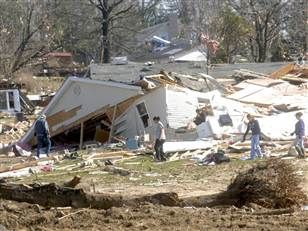
© TODAY
A "very large super-cell" of several small and perhaps one big tornado touched down in northern Alabama Friday morning, damaging homes and a high school across a wide area, leaving many injured and without power, emergency officials say.
The damage covered a 4 to 5 mile swath in northern Madison County, Paige Colburn, emergency management officer at the Huntsville-Madison County Emergency Management Agency, told msnbc.com.
"The reason that it is so wide is because we're not talking about one tornado, we're talking about a very large super cell that spawned several smaller tornadoes and there's possibly one very large one in there, too," she said.
Buckhorn High School was hit and has reported minor damage to the roof. Students sheltered at the school and there were no injuries reported. Some 17,000 people in the county are without power, but that was possibly a low estimate, Colburn said.
"Temporary shelter is being setup," Colburn said. "The storm has passed the county, thank goodness, and we are now working on response/recovery, life-saving and property-saving procedures," she added.
Two
back-to-back tornadoes also struck neighboring Limestone County Friday morning, local emergency officials told The Huntsville Times. The sheriff's office told NBC News there were reports of trees down and damage to some homes.
A training building at a local prison - Limestone Correctional Facility, which houses 2,100 inmates - was destroyed by a tornado, and two dorms and two other buildings suffered roof damage, Brian Corbett, a spokesman for the state Department of Corrections, told NBC.
No one was hurt, and the prison was operating on generator power. The state has sent extra security, Corbett added.
Warnings for many statesAlabama was one of a number of states that forecasters warned may experience severe storms and twisters on Friday.
"We're forecasting
an outbreak of strong tornadoes and damaging wind both today and into the overnight hours over a large portion of the eastern United States. The area of highest risk is focused on southern Illinois, southern Ohio, much of Kentucky and Middle Tennessee," Russell Schneider, director of the National Weather Service's Storm Prediction Center, said at a phone news conference. "In those areas there's potential for violent long-track tornadoes during the afternoon and evening hours."
A combination of strong winds and warm moist air "reminiscent of late spring" were fueling the formation of storms into strong super-cell thunderstorms that had the potential for the extreme tornadoes, he said.
The threat extends into a broader area that's not quite as high risk but still a "major severe weather event," including
the potential for strong tornadoes across southern Illinois, Indiana, Ohio, portions of West Virginia, through much of Tennessee into the southeast, including Mississippi, Alabama and Georgia, Schneider said.
"This is going to be a very extensive severe weather outbreak, including the potential for strong, violent tornadoes," he added, noting it was the fifth "high risk" -- their highest threat level -- they've issued during the month of March since 2000.
"This means they're very serious situations and people should be prepared for severe weather conditions in their local areas. The storms will be moving very rapidly they're developing at this time, particularly centered - some storms in Alabama and southeastern states - other storms have already developed in Illinois," Schneider said.
A particularly dangerous tornado watch has been issued for southern Illinois, parts of southeast Missouri, extreme western Kentucky and southwest Indiana.
"There, dangerous conditions are ongoing at this time. Storms will be moving -- almost 50 to 60 miles an hour -- so severe weather conditions will change rapidly at any given location," he said.
The severe weather risk area is over some urban but also "very dense rural populations," so "the risk to property and people is substantial on a widespread outbreak of this variety," Schneider said.
A storm system earlier this week in the Midwest and South killed 13 people in four states.
"The unfortunate truth about spring weather patterns is they can lead to repeated severe outbreaks, sometimes in areas that were already hard hit," wrote Jonathan Erdman, a senior meteorologist for weather.com. "Such a situation is looking to unfold in parts of the Ohio, mid-Mississippi, and Tennessee Valleys Friday."
March is the start of the core of severe weather season over much of the country, Schneider said. "As far as any trends for the season, certainly this has been a very active week or two, but we really can't make any judgment on the full extent of the season at this time."
'God, please don't let there be another'Kera Wise was one of those picking up the pieces after a tornado struck Harrisburg, Ill., early Wednesday. She was quickly scouring for keepsakes from her aunt and uncle's ruined home ahead of the forecasts for more severe weather, though by early Friday it seemed the town had escaped any major overnight storms unscathed.
"You just keep thinking, 'God, please don't let there be another tornado,'" Wise, 35, whose aunt and uncle remained hospitalized in neighboring Indiana, told The Associated Press.
Reader Comments
to our Newsletter